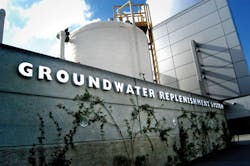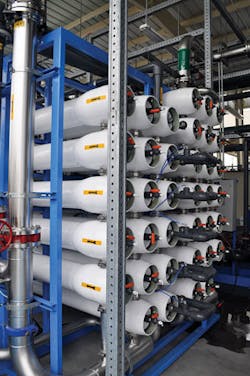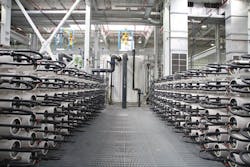The Recycling Revolution: Water Recycling Trends, Technologies in CA amid Ongoing Drought
By Art Haddaway, WaterWorld Editor
The current drought plaguing much of the Western United States - particularly California - is one of the most severe droughts on record and has significantly impacted major water resources throughout the region. The persistent lack of rainfall and continuing dry conditions over the last four years have led to drastically depleted water supplies, ultimately affecting many industries and municipalities across the state.
Recent statistics from the U.S. Drought Monitor (UDM) reveal that nearly all of California is experiencing at least some form of drought, with most of the central and northern parts of the state (nearly 46 percent) undergoing an “exceptional” drought. Further, it has affected nearly 37 million people across California - about half the total of the U.S. population located in drought-affected areas, according to the UDM.
Growing water scarcity throughout the Golden State has caused a variety of devastating economic and environmental problems, including job loss, agricultural and landscape deficiencies, local waterway damage, and diminishing water quality. However, while California continues to experience this intense drought and face the many challenges it presents, the state is embracing a number of innovative trends and technologies relating to water recycling.
Water recycling, also referred to as water reuse or water reclamation, is an effective method of treating captured or conveyed wastewater and redistributing it to benefit other water-dependent applications. Unlike traditional approaches where water is merely discharged as waste after use, water recycling provides a reliable local water supply, helping improve water conservation, cut energy use and costs, minimize diversions from local waterbodies, and prevent water pollution.
A recent report from Heal the Ocean indicated that 43 wastewater treatment facilities in California discharge approximately 1.35 billion gallons per day (~1.5 million acre feet per year) of treated effluent directly into the Pacific Ocean. However, progress is being made in the area of water recycling, according to a new report by the Pacific Institute. The research showed that an estimated 670,000 acre-feet of municipal wastewater is being reused in California each year and that onsite reuse is also being practiced in communities across the state.
“Essentially there has been a ramping up of [water recycling]. Many are starting to look at recycling water and the opportunities that it can provide,” said Heather Cooley, director of Pacific Institute’s water program. “Recycled water can provide a water supply benefit - a new reliable source of water. In many cases though, the water that we’re discharging into rivers, streams and oceans is polluting those systems. By capturing and reusing this water, we’re providing a water quality benefit as well.”
Throughout the last decade, a number of California water districts, agencies and organizations have stepped up - and on some occasions collaborated - to implement these water recycling techniques and technologies across the state to better combat the current drought. Moreover, as indicated in the Pacific Institute report, many “water utilities in Northern and Southern California have already made investments in recycled water, and many are seeking to expand their recycled water supplies.”
Edward C. Little Recycling Facility
West Basin Municipal Water District’s Edward C. Little Water Recycling Facility, located in the city of El Segundo, Calif., is a state-of-the-art treatment utility incorporating unique and advanced water purification and conservation techniques to overcome the drought and provide a reliable source of water to Southern California communities. The plant was recently expanded from 46 to 62 million gallons per day (MGD) and serves approximately 300 sites through 120 miles of distribution pipes.
The largest recycling facility of its kind in the world, Edward C. Little converts secondary wastewater effluent imported from the Hyperion Wastewater Treatment Plant in Los Angeles into ultra-high-quality recycled water, which is delivered to municipal, industrial and commercial customers for a variety of indirect and non-potable applications, including cooling, landscape and irrigation, and groundwater replenishment.
One of the primary distinct ways the utility helps meet the needs of customers is by producing five different types of usable, customized ‘designer’ waters out of its treated wastewater. These include irrigation water through tertiary disinfection; cooling tower water through nitrification; low-pressure boiler feedwater through single-pass reverse osmosis (RO); high-pressure boiler feedwater through double-pass RO; and indirect drinking water through microfiltration, RO and ultraviolet (UV) light with hydrogen peroxide (H2O2).
“With these five designer waters, we can really tailor it for [customers’] needs,” said Shivaji Deshmukh, West Basin assistant general manager. “Those waters range in quality from good enough to water a lawn or golf course [to] highly-treated water that’s actually too pure to drink. It really allows us to be more efficient with the way we treat our water rather than just over-treating all the water and distributing it to our customers.”
In February of this year, Edward C. Little reached a record-high 150 billion gallons of total recycled water - a supply that’s expected to serve approximately 3.7 million people for one year. Further, the facility is currently conserving enough water to meet the needs of 80,000 households annually at full capacity. The plant’s purification efforts are significantly contributing to West Basin’s goal of maximizing the amount of recycled water use in its service area while also improving water conservation by reducing its dependence on imported water (66 percent to 33 percent by 2020) as part of its Water Reliability 2020 Program.
“Every drop of water, every acre foot of water we produce at our facility, makes it easier for our neighbors and state as well,” said Deshmukh. “We lessen the demand on those imported supplies, whether they’re from the State Water Project within the state of California or the Colorado River. When the river starts to have supply issues, we’re developing our own local supplies here - it’s one less acre foot we have to rely on from those other sources.”
In 2002, Edward C. Little was designated by the National Water Research Institute and U.S. Bureau of Reclamation as a National Center for Water Treatment Technologies - one of only six in the country.
Silicon Valley Advanced Water Purification Center
This July, the Santa Clara Valley Water District opened the Silicon Valley Advanced Water Purification Center (SVAWPC) in San Jose, Calif., to serve as a locally-controlled, drought-proof water source for the region. The $72-million, 8-MGD facility is the largest of its kind in Northern California and is the result of a partnership between the Water District and the city of San Jose. The two entities started the state-of-the-art utility as the focal point of recycled water expansion and to produce highly-purified water that would match primary drinking water standards.
The SVAWPC utilizes three advanced purification processes - microfiltration, RO and UV disinfection - to further treat the secondary effluent imported from the San Jose-Santa Clara Regional Wastewater Facility (RWF). Rather than being discharged into the San Francisco Bay, the Santa Clara Valley Water District’s new plant blends this water with its purified water to provide a high quality product that’s distributed to commercial, industrial and municipal applications for non-potable use through RWF’s South Bay Water Recycling “purple pipe” program.
Parks, golf courses, cooling towers, and car washes, for example, are all benefiting from the lower total dissolved solids (TDS) that SVAWPC is producing as a result of its purification process. According to Marty Grimes, program administrator for the Santa Clara Valley Water District’s Communications Unit, the treated water contains an average TDS concentration of 40 parts per million (ppm), and when that water is blended with the treated wastewater that has a TDS of 720 ppm, the final result is water that has a TDS of about 500 ppm.
The lower TDS provides a number of benefits. “Industrial customers would require less pre-treatment to avoid scaling, while landscape users would see reduction in leaching to remove excess salt from the soil,” said Grimes. “The enhanced water quality also reduces the potential for degrading groundwater quality in sensitive groundwater basins.”
In addition to continuing to develop its non-potable services, the Santa Clara Valley Water District is also looking to expand the future drinking water supplies of the region with its purification efforts. In light of ongoing development of direct potable reuse regulations in California, the center is pursuing the possibility of potable reuse through demonstration testing for both indirect and direct potable reuse applications. Testing began in September 2014 with final reporting due in early 2016, according to Grimes.
“In our county, recycled water makes up about 5 percent of our total water supply. Our goal is to increase that to 10 percent by 2025,” said Grimes. “This increase will help us weather multiyear droughts in the future. Getting to 10 percent will require using purified recycled water for potable uses.”
The Santa Clara Valley Water District also recently received the prestigious “Project of the Year Award - Large” from the WateReuse Association for its completion of the Silicon Valley Advanced Water Purification Center.
Groundwater Replenishment System
Launched in January 2008 and expanded in May 2015, Orange County Water District’s Groundwater Replenishment System (GWRS) is an innovative, $623-million, drought-proof water purification and recycling project that produces near-distilled-quality water for groundwater aquifer recharging and seawater intrusion prevention across the region. The facility recycles 100 MGD (reaching nearly 850,000 residents) and provides 70 percent of the overall potable water supply for the 2.4 million people in north and central Orange County (OC).
GWRS is a jointly-funded project between OC Water District and OC Sanitation District that serves as the world’s largest water purification system for planned indirect potable reuse. The utility replaced Water Factory 21, a seawater intrusion prevention project built in 1976, which served as the first facility to achieve potable-grade-quality water through RO technology. Similar to the treatment methods used by Silicon Valley, GWRS uses RO, microfiltration and UV with H2O2 to purify the secondary wastewater from OC Sanitation District that would otherwise be discharged into the Pacific Ocean.
“By the time [the water] has gone through the advanced purification facility, it is of a distilled quality. We’ve stripped just about everything out of the water,” said Mike Markus, OCWD general manager. “It also improves the water quality of the groundwater basin. We’re taking ultrapure water, which has low mineral content, and we’re mixing it with groundwater that has higher mineral content. Overtime, that blending will reduce the mineral content in the groundwater basin.”
Producing water that exceeds all federal and state drinking water standards, GWRS allocates 35 MGD of this recycled water to maintain the seawater intrusion barrier in injection wells along Huntington Beach and Fountain Valley and the remaining 65 MGD to naturally filter sand and gravel in the Kraemer, Miller and Miraloma percolation basins across the city of Anaheim. Further, the process by which GWRS recycles and distributes this water reduces the region’s reliance on imports from Northern California and the Colorado River, ultimately cutting maintenance costs, energy consumption and reliance on depleting resources.
“The benefit is that we have control over this source of water - the concept of water supply reliability. We can produce the water at less than what it currently costs to purchase potable water supplies,” said Markus. “We can also do it for half the energy that it takes to bring that imported water from Northern to Southern California. We can do it for a third of the energy costs it would take to desalinate the seawater.”
To date, GWRS has produced over 165 billion gallons of recycled water. As part of a recent feasibility study, the OC Water District is looking to expand the system to 130 MGD; the $142.7-million project would bring its total production to 103,000 acre feet per year. Both the OC Water District and OC Sanitation District have been honored with the U.S. Water Prize in recognition of the GWRS. Likewise, the OC Water District won the 2014 Lee Kuan Yew Water Prize for its exceptional work in groundwater management and water reclamation using advanced water reuse technologies.
Advanced Water Purification Facility
The city of San Diego’s 1-MGD Advanced Water Purification Facility (AWPF) - a key component of a larger recycling demonstration project - is comprised of a unique multi-barrier treatment process. Launched in 2011, 12 months of formal testing showed that it can consistently produce high-quality drinking water that meets federal and state standards. The overall demonstration project proved that augmenting the San Vicente Reservoir with purified water is feasible, not only from a technology perspective but from public acceptance and cost perspectives as well.
The pioneering facility, located at the North City Water Reclamation Plant (North City), utilizes microfiltration, ultrafiltration, RO, advanced UV, and H2O2 oxidation to further purify the tertiary-treated water at North City. Once treated, the high-quality is then sent to the reservoir, where it is stored for an extended period of time before undergoing a final round of treatment and being reintroduced to San Diego’s drinking water system.
What makes San Diego’s concept unique is that it is the first utility in California to apply the practice of indirect potable reuse (IPR) toward the augmentation of a reservoir. San Diego is heavily reliant upon distant water sources such as the Bay Delta and Colorado River, and advanced water purification contributes significantly to reducing this trend. Moreover, at full build-out, the project has the potential to provide 83 MGD of water, which is about a third of the city’s future water need. It is a dependable drinking water supply, conserving energy and importation costs.
“This facility is a demonstration facility, and we needed to build it because we wanted to do the testing and wanted to be sure the technology is working well in San Diego,” said Halla Razak, director of public utilities department, city of San Diego. “With the finding that we’ve had, it paves the way for us to implement a larger project, and it paves the way for many other agencies that are watching San Diego carefully, because they themselves have their own plans to do indirect potable reuse.”
AWPF’s advanced treatment has contributed to Pure Water San Diego, a wide-scale, 20-year education and treatment program to provide the city with a dependable and cost-effective drinking water supply. San Diego is also planning to expand the facility to produce up to 30 MGD and is scheduled to be operational by 2021. The long-term goal - producing 83 MGD - is scheduled for 2035. Further, AWPF welcomed its 7,500th tour guest in April of this year - an accomplishment that ultimately prompted a historic milestone for the utility.
Ongoing Efforts
Along with these four leading projects, other influential water reuse and conservation efforts have been carried out that are helping to combat the drought and pave the way toward a better future for California’s water resources.
On November 4, 2014, state voters approved the $7.5-billion Proposition 1 water bond - the Water Quality, Supply and Infrastructure Improvement Act of 2014. As part of the first wave of allocations that California Governor Jerry Brown has made this year, nearly $140 million is going toward water recycling projects, such as using treated sewage water for landscape irrigation and other uses, ultimately conserving drinking water supplies.
On March 19, 2015, Brown and a group of state lawmakers also unveiled a $1-billion emergency drought relief plan - allocating roughly $270 million from November’s bond - that involves, for instance, a strong focus on accelerating water reuse and recycling endeavors throughout the state. Likewise, the governor announced an executive order at the beginning of April that complements the water bond and relief plan by issuing mandatory water reductions, investment in new water-related technologies, implementation of conservation pricing in water rates, and more.
“[Santa Clara] has benefitted from Governor Jerry Brown’s Emergency Drought Package by receiving critical funding to help convey drought-proof recycled water to some of the country’s largest high-tech companies,” said Grimes. “Additionally, we are utilizing drought monies from the package to promote water conservation as a way of life here in California. With an eye to the future, District leaders are currently assessing additional funding opportunities in the expansion of recycled water infrastructure throughout the greater Silicon Valley.”
The State Water Resources Control Board’s mandate called for urban water cuts statewide by 25 percent over nine months. Initial estimates from the board indicated that in June - the first official month of the order - California’s water use dropped by more than 27 percent, with 265 water entities (serving 27.2 million people) meeting or exceeding the standard and 150 agencies (serving 8.5 million people combined) falling short of achieving the goal. Many ongoing water reuse and recycling projects - including the aforementioned endeavors - are contributing to these conservation trends.
“Though the governor has called for a statewide 25-percent reduction in urban water use, West Basin’s service area is asked to reduce by 20 percent because of the water recycling and conservation programs that we already have in place,” said Deshmukh. “While West Basin is not directly affected by the mandate, as a water wholesaler, we are working closely with our cities and retailers to provide free workshops and classes to help residents and businesses continue conserving water during the drought.”
Several prominent small- and large-scale water recycling, treatment and conservation projects are also bringing impactful change to California that include, for example, the City of Corona Water Recycling and Reuse Project, Hi-Desert District Wastewater Collection and Reuse Facility in Yucca Valley, San Francisco Public Utilities Commission’s Groundwater Supply Project, and Southern California Desert Region Integrated Water and Economic Sustainability Plan, to name a few. Further, other localities such as the Water Replenishment District, Metropolitan Water District and Central Basin Municipal Water District are among many leading the way in water recycling and conservation in California.
Conclusion
Whether it’s utilizing new innovations to purify water or making extra efforts to conserve water, projects like these are proving that California holds much potential when it comes to reusing water. “There tends to be a lot of doom and gloom around a drought, but if there’s any silver lining, it’s that it forces us to rethink how we use and manage water resources - and this drought is no different,” said Cooley. “It is really making us take a hard look at how we use water and what ways we are using it more effectively.”
“I want people to understand that all the water on this planet is recyclable and the fact that today there is no pure water on the planet - the only pure water comes from recycling facilities like ours,” said Ron Wildermuth, West Basin public information officer. “What we’re doing is the future, and it’s a future that’s going to be a lot more sustainable than things we’ve done in the past.”
“We have to recycle our water. It’s a limited resource, a precious resource,” said Markus. “We have the technology, the know-how to be able to treat wastewater into highly purified water, water that’s perhaps the purest water that we’re able to produce.” Further, Deshmukh added, “We’re taking a product/resource that most people view as a waste and are turning it into the highest quality of water around. Not only are we doing an amazing thing in terms of recycling the waste, but we’ve been able to get people excited about the concept.”
Advanced Metering Increases Water Efficiency, Aids Conservation During Historic Drought
The drought-stricken resort town of Mammoth Lakes, Calif., cannot import water, and with no snowmelt runoff or surface water, it is almost completely dependent on groundwater wells for supply. Before implementing Neptune Technology Group’s R450 System for fixed-network AMI, the Mammoth Lakes Community Water District could only collect consumption data on-site from select meters. Now it can track consumption for all accounts automatically. Leveraging the Neptune System’s hourly consumption data, Mammoth Lakes has easily met the state’s mandated 20-percent reduction in water usage and its own call for a 30-percent reduction. And by identifying accounts with continuous usage, the District has saved a projected annual 32 million gallons of water.
More WaterWorld Current Issue Articles
More WaterWorld Archives Issue Articles
About the Author

Art Haddaway
Assistant Editor
Art Haddaway is the Assistant Editor of WaterWorld and Industrial WaterWorld magazines. A writer and editor of over 10 years, he has contributed to a variety of regional publications covering everything from current events to creative features. Art is a graduate of Oral Roberts University in Tulsa, Okla., with a bachelor’s degree in print journalism.




